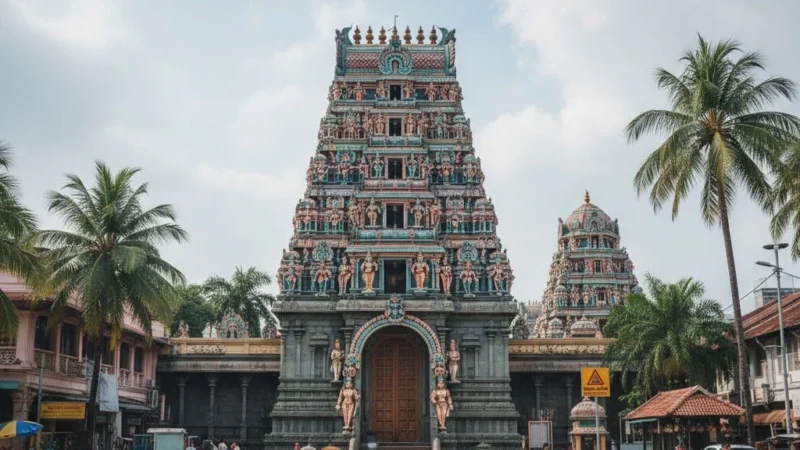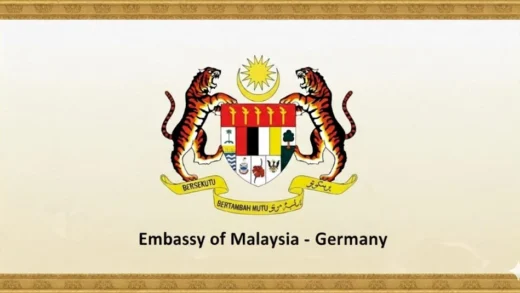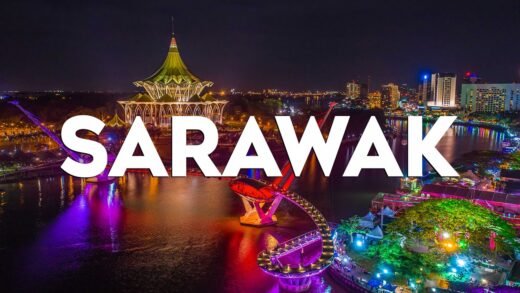Sri Mahamariamman Temple, Kuala Lumpur

Sri Maha Mahamariamman Temple
Sri Mahamariamman Temple is the oldest and most prominent Hindu temple in Kuala Lumpur, Malaysia. Established in 1873, it serves as a spiritual, cultural, and historical landmark for the Tamil Hindu community. Renowned for its Dravidian architecture, the temple is a must-visit site for devotees and tourists alike.
| Category | Details |
|---|---|
| Name | Sri Mahamariamman Temple (Kuil Sri Mahamariamman) |
| Location | 163, Jalan Tun H S Lee, 50000 Kuala Lumpur, Malaysia |
| Founded | 1873 |
| Founder | K. Thamboosamy Pillai |
| Deity | Goddess Mariamman (Hindu goddess of rain, fertility, and disease protection) |
| Architecture Style | Dravidian (South Indian temple style) |
| Main Attraction | The 22.9-meter-high gopuram (tower) with 228 intricately sculpted deities |
| Opening Hours | Daily 6:00 AM – 8:30 PM (hours may vary on festival days) |
| Entry Fee | Free (donations accepted) |
| Dress Code | Modest attire required (shoulders and knees covered) |
| Nearest MRT/LRT Station | Pasar Seni (LRT Kelana Jaya Line / MRT Kajang Line) – 3 min walk |
| Nearby Attractions | Petaling Street (Chinatown), Central Market, Guan Di Temple |

History
- Founded: 1873 by early Tamil immigrants in Kuala Lumpur.
- Originally served as a small shrine for local Hindu workers.
- Expanded over the decades to accommodate growing numbers of devotees.
- Has remained a cultural hub, preserving South Indian traditions and religious practices in Malaysia.
- In 1968, a new structure was built, featuring the ornate ‘Raja Gopuram’ tower.
Historical Significance
Sri Mahamariamman Temple is more than a religious site. It represents the heritage of the Indian community in Malaysia and reflects the multicultural fabric of Kuala Lumpur. Its establishment coincided with the growth of Kuala Lumpur as a trading and tin-mining hub, providing a spiritual home for early settlers.
Here’s a well-structured, Wikipedia-ready summary of your provided text about the Sri Maha Mariamman Temple, Kuala Lumpur, written in encyclopedic tone and proper format:
Architecture
Gopuram
Built in the South Indian Dravidian style, the temple’s most prominent architectural feature is its five-tiered gopuram (tower), which serves as the tallest structure in the complex. The striking 22.9 m (75 ft) high pyramid-shaped gate tower is elaborately decorated with sculptures of Hindu deities, crafted by skilled artisans from southern India. The chief sculptor, the late S. T. Muniappa from Tamil Nadu, is credited with creating 228 idols that adorn the gopuram.
Main Prayer Hall
The temple is designed to symbolically resemble a human body lying on its back, with the head facing west and the feet pointing east. The five-tiered gopuram corresponds to the feet, representing the threshold between the material and spiritual realms.
At the rear lies the garbhagraham (sanctum sanctorum), corresponding to the head of the symbolic human form. This freestanding structure has its own roof and walls, with a single east-facing entrance. Inside, the chief deity, Sri Maha Mariamman, is enshrined. The priest stands before the garbhagraham during puja (prayers).
The main prayer hall features intricately decorated ceilings and an ornate onion dome marking the location of three central shrines, visible from outside the temple. Four smaller shrines surround the main structure.
Within the temple, Pillaiyar (Lord Ganesha) occupies the shrine on the left, while Lord Muruga resides on the right. Pillaiyar is also placed at the entrance as the remover of obstacles. The eight idols adorning the inner pillars represent the Ashta Lakshmi (the eight forms of Goddess Lakshmi).
Following traditional Hindu custom, the temple undergoes reconsecration every 12 years.
Silver Chariot
A notable feature of the temple is its silver chariot, prominently used during the annual Thaipusam festival. The chariot carries the statues of Lord Muruga and his consorts, Valli and Teivayanni, through the streets to Batu Caves.
The chariot, first used in 1983, was constructed in India and shipped to Malaysia in 12 parts for assembly. It stands 6.5 metres tall, weighs 350 kilograms of silver, and includes 240 bells and a pair of sculpted horses. It was built at a cost of RM 350,000. Prior to this, a wooden chariot made in 1930 at a cost of RM 50,000 was used.
Bangunan Mariamman
After a 40-year wait, the temple complex expanded with the addition of a new six-storey building, known as Bangunan Mariamman, officially opened by Datuk Seri S. Samy Vellu, Minister of Works and President of MIC.
The RM 13 million building, located behind the temple on Jalan Tun H. S. Lee, features two basement car park levels, two auditoriums, and a large hall. The idea for its construction was first proposed by Datuk Seri S. Samy Vellu nearly 38 years earlier, when he served as a committee member. The building stands adjacent to the Klang Bus Station and opposite the Pasar Seni LRT/MRT station, and is directly connected to the temple.
Deity
Mariamman, the presiding deity, is revered among overseas Tamil and South Indian communities, who regard her as their protector in foreign lands. She is considered a manifestation of the goddess Parvati, embodying the nurturing and protective aspects of Mother Earth, and is believed to shield devotees from unholy or demonic influences.
Administration
The Sri Maha Mariamman Temple is administered by the Board of Management of Sri Maha Mariamman Temple Devasthanam, which also oversees the Batu Caves Sri Subramaniam Temple and the Kortumalai Pillaiyar Temple.
The board serves as the Hindu Religious Consultant to the Government of Malaysia, providing guidance on the Hindu religious calendar and festival dates.
Location & Address
- Address: 163, Jalan Bandar, City Centre, 50000 Kuala Lumpur, Malaysia
- Nearby landmarks: Petaling Street (Chinatown), Central Market, Masjid Jamek, Kuala Lumpur City Centre
- Accessibility: Easily reachable by taxi, Grab, or walking from Pasar Seni LRT Station (~5 mins walk).
Opening Hours
| Day | Opening Hours |
|---|---|
| Thursday | 6 am – 8:30 pm |
| Friday | 6 am – 9:30 pm |
| Saturday | 6 am – 9:00 pm |
| Sunday | 6 am – 8:30 pm |
| Monday | 6 am – 8:30 pm |
| Tuesday | 6 am – 8:30 pm |
| Wednesday | 6 am – 8:30 pm |
Timings & Entry Ticket Fee
- Opening Hours: Daily, 6:00 AM – 9:00 PM
- Special Hours: Extended during festivals like Deepavali and Thaipusam
- Entry Fee: Free for all visitors (donations appreciated for temple maintenance)
Architecture & Features
- Dravidian Style: Vibrant gopuram (tower) at the entrance with intricate sculptures of gods and goddesses.
- Main Deity: Goddess Mariamman, revered for protection and healing.
- Shrines: Includes Lord Ganesha, Lord Murugan, and Lord Shiva.
- Decorations: Colorful carvings, paintings, and ornate ceilings depict Hindu mythology.
- Courtyard & Pillars: Traditional South Indian craftsmanship, ideal for photography and cultural appreciation.
What you’ll find
- Fresh flower garlands (jasmine, marigolds etc) made for offerings.
- Loose flowers, rope garlands, fresh bundles for temple offerings.
- Pooja items like incense, small lamps, offerings – though items beyond just flowers may be at nearby shops, not necessarily the single stall.
- The vendors start early (often at dawn), given the temple’s early rituals.
What to Do
- Offer Prayers: Participate in rituals at the sanctum sanctorum.
- Observe Rituals: Watch daily pujas (prayers) and ceremonies.
- Festive Experience: Visit during Deepavali, Thaipusam, or Navaratri to see temple celebrations.
- Cultural Learning: Learn about South Indian architecture, art, and traditions.
- Photography: Capture the vibrant gopuram and temple interiors (respectfully).
What Not to Do
- No Shoes: Remove footwear before entering the temple.
- Respect Dress Code: Wear modest clothing covering shoulders and knees.
- No Loud Behavior: Maintain silence inside the sanctum.
- Avoid Flash Photography: Follow temple rules regarding photography in certain areas.
- Do Not Disturb Rituals: Refrain from interrupting ceremonies or priests.
Festivals & Events
- Deepavali (Diwali): Temple illuminated, prayers, and cultural performances.
- Thaipusam: Special ceremonies and offerings, although Batu Caves is the main Thaipusam site.
- Navaratri: Nine-day celebration with music, prayers, and flower offerings.
- Panguni Uthiram: In 2026, Panguni Uthiram is expected to fall on Monday, March 30, 2026, according to the Tamil calendar.
- Other Celebrations: Tamil New Year, monthly poojas, and special events for devotees.
Interesting Facts
- One of the oldest Hindu temples in Malaysia, over 150 years old.
- Serves as a hub for Tamil cultural preservation, hosting music, dance, and language programs.
- Temple gopuram statues are hand-painted and represent hundreds of deities from Hindu mythology.
- Offers free prasadam (holy food offerings) to devotees during special occasions.
Near By Restaurants
| Restaurant | Type | Distance | Specialty |
|---|---|---|---|
| Restoran Yusoof & Zakhir | Indian Muslim | 2 min walk | Nasi briyani, teh tarik |
| Restoran Sri Ganesa | South Indian | 3 min walk | Banana leaf rice, dosa |
| Butter Kaya Kopitiam | Local Café | 4 min walk | Kaya toast, coffee |
| Old China Café | Peranakan | 5 min walk | Nyonya laksa, rendang |
| Merchant’s Lane | Fusion Café | 6 min walk | Brunch, desserts, coffee |
Near By Food Streets
| Street / Area | Type | Highlights |
|---|---|---|
| Petaling Street | Night Market | Famous for Hokkien mee, roasted duck, and dim sum. |
| Jalan Tun H S Lee | Local Eateries | Indian and vegetarian restaurants near the temple. |
| Jalan Sultan | Heritage Cafés | Coffee shops and fusion brunch places. |
| Brickfields (Little India) | Indian Cuisine Hub | Idli, dosa, banana leaf meals, sweets, and spices. |
Nearby Attractions to Sri Mahamariamman Temple
| Place Name | Type | Distance from Temple | Highlights |
|---|---|---|---|
| Petaling Street (Chinatown) | Shopping & Food Street | 🏃 2 min walk | Street food, souvenirs, clothes, and Chinese herbs. |
| Central Market (Pasar Seni) | Cultural Market | 🚶 4 min walk | Malaysian handicrafts, batik art, and local snacks. |
| Guan Di Temple | Taoist Temple | 🚶 2 min walk | Dedicated to Chinese god of war, Guan Di; beautiful incense-filled atmosphere. |
| Sin Sze Si Ya Temple | Taoist Temple | 🚶 5 min walk | Oldest Taoist temple in KL, known for good fortune blessings. |
| Kwai Chai Hong | Heritage Lane | 🚶 7 min walk | Restored alley with murals, cafés, and heritage Chinese shophouses. |
| Merdeka Square (Dataran Merdeka) | Historic Landmark | 🚗 5 min (1 km) | Iconic KL flagpole and colonial architecture. |
| Sultan Abdul Samad Building | Historical Site | 🚗 5 min (1 km) | Victorian-Moorish architecture, lit beautifully at night. |
| River of Life (Masjid Jamek) | Scenic River Walk | 🚶 8 min | Blue-lit night view and water features. |
| National Textile Museum | Museum | 🚗 5 min (1 km) | Traditional Malaysian textiles and fashion exhibits. |
| Kasturi Walk | Street Market | 🚶 4 min | Open-air street next to Central Market for quick snacks and souvenirs. |
Conclusion
Sri Mahamariamman Temple is a spiritual, cultural, and historical gem in the heart of Kuala Lumpur. Whether you are a devotee, tourist, or history enthusiast, visiting the temple offers insight into the rich Indian heritage of Malaysia, the artistry of Dravidian architecture, and the vibrancy of Hindu festivals. It is a must-visit for anyone exploring Kuala Lumpur’s multicultural landscape.
FAQ
What time does the Sri Maha Mariamman Temple open in Kuala Lumpur?
Sri Mahamariamman Temple is open: Sunday to Thursday: 06:00 – 13:00 & 16:00 – 20:30. Fridays: 06:00 – 13:30 & 16:00 – 21:30.
What is KL Mariamman Temple famous for?
Built in the South Indian style, the temple’s most outstanding feature is the impressive 5-tiered gopuram (tower). It is the tallest structure in the temple. The dramatic 22.9 m (75 ft) high pyramid-shaped gate tower is decorated with depictions of Hindu gods sculpted by artisans from southern India.
What is the history of Sri Mariamman Temple?
The history of the Sri Mariamman Temple centers on its founding in 1827 by Naraina Pillai, an Indian pioneer who helped establish Malaysia and Singapore’s Hindu community.
How do I dress to visit Mariamman temple KL?
Visitors should dress modestly. Men are advised to wear full-sleeved shirts and trousers. Women should ensure that their clothing covers the shoulders and knees. Removing footwear before entering the temple is mandatory.





Comments are closed.